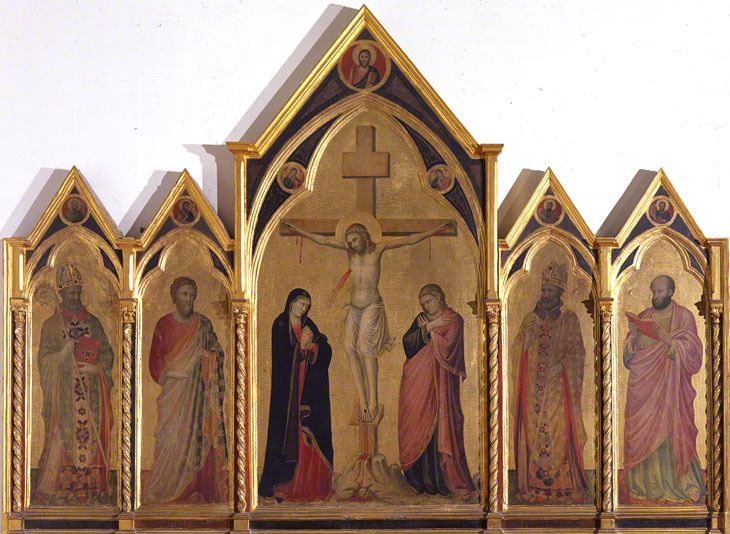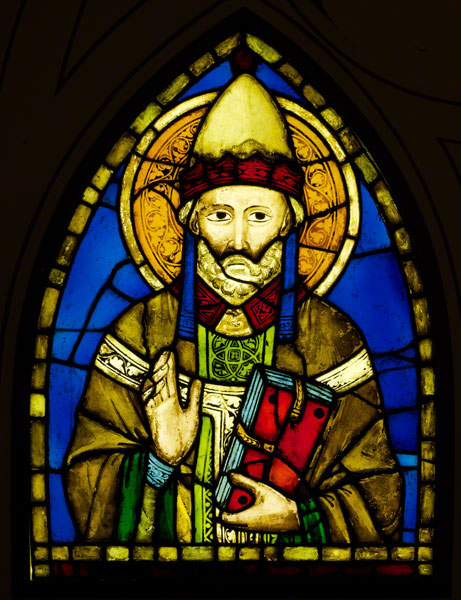Devotional Art
Throughout the Middle Ages, various types of paintings and manuscripts were
created to aid Christians in their religious devotion. This production increased in the
early 14th century with the rise of the mendicant (preaching) orders of the
Franciscans and the Dominicans, both of which sponsored much of the art produced
in Florence during this period. Although today these objects are often viewed
separately from each other in museums, they functioned together in liturgical
ceremonies, especially the Mass.
Altarpieces

This impressive altarpiece is one of Pacino's largest painting commissions and his only signed work. Made for the high altar of the Church of San Firenze (Saint Florentius), it displays a central Crucifixion scene flanked by Saints Nicholas and Bartholomew, at left, and Saints Florentius and Luke, at right. The inscription that runs along the base identifies these saints, the patron (the priest Simon), the artist (Pacino di Bonaguida), and provides a partial date (MCCCX[…]). The figures' beautifully modeled drapery and sensitive expressions place this polyptych among Pacino's highest quality works.
Stained-Glass Windows
In addition to the multipaneled paintings, such as the altarpiece above, that graced the altars of chapels, large-scale crucifixes hung above altars, illuminated manuscripts provided sources for biblical texts and hymns, small crosses were carried in procession in churches and through the streets, and stained-glass windows provided luminous scenes on the walls of the church space.

The ecclesiastical rank of this figure can be determined by the vestments that he wears. This pope-saint wears the tiara of the papacy. Pacino designed this window for the Church of Santa Croce in Florence at a time when he likely worked alongside Giotto and drew inspiration from the elder artist's paintings and stained glass there.
Private Devotion
Individual worship outside the Mass also took place in private family chapels and in the cells of monks and friars, and smaller panel paintings, such as diptychs and small triptychs, enhanced this devotion.


These panels once formed a diptych made for private devotion. Together, they represent hallmarks of Giotto's style, from monumental figures painted naturalistically, on the left, to a wide range of psychological and emotional responses in a single composition, at right.
At left, the Virgin and Child are surrounded by saints (with round halos), including John the Baptist and Francis, and seven female figures (with hexagonal halos) who represent the virtues. The figure at right presenting her heart to Christ is Charity, followed clockwise by Obedience, Fortitude, Faith, Prudence, Humility, and Hope. In the Crucifixion scene, at right, angels fly through a golden sky, some catching blood from Christ's wounds and others rending their garments in grief. Onlookers stand to the right, Saint Mary Magdalene clutches the cross at center, and a swooning Virgin Mary is supported by two women at left.
At left, the Virgin and Child are surrounded by saints (with round halos), including John the Baptist and Francis, and seven female figures (with hexagonal halos) who represent the virtues. The figure at right presenting her heart to Christ is Charity, followed clockwise by Obedience, Fortitude, Faith, Prudence, Humility, and Hope. In the Crucifixion scene, at right, angels fly through a golden sky, some catching blood from Christ's wounds and others rending their garments in grief. Onlookers stand to the right, Saint Mary Magdalene clutches the cross at center, and a swooning Virgin Mary is supported by two women at left.
Publication
Florence at the Dawn of the Renaissance: Painting and Illumination 1300–1350
Edited by Christine Sciacca
Edited by Christine Sciacca
Related Information
At the Art Gallery of Ontario
- Revealing the Renaissance: Stories and Secrets in Early Florentine Art
March 16–June 16, 2013

